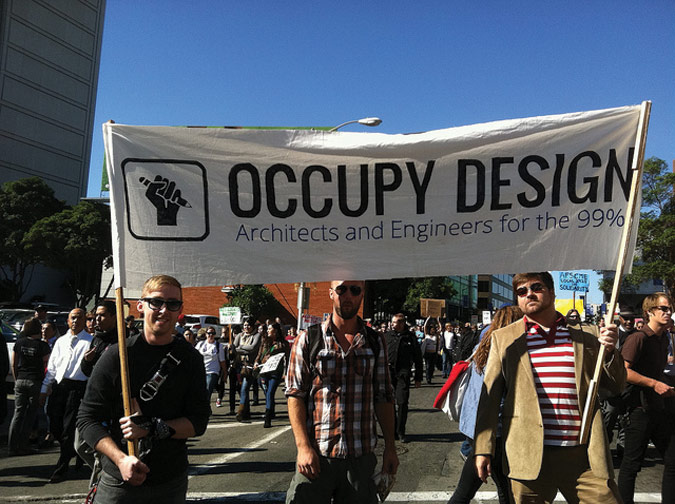
In scanning the Occupy protests that have sprung up around the country it becomes apparent that the same set of iconic images are cropping up at almost every one. This, it turns out, is the work of a group of designers who call themselves OccupyDesign. “Building a visual language for the 99%”, proclaims their website.
The group, headed by designer Jake Levitas, coalesced as part of nationwide "hackathons" that spontaneously emerged in support of Occupy Wall Street. The San Francisco-based creatives and demonstrators who form its core use design to counter mischaracterizations of the Occupy movement in the media and provide downloadable signs and icons to facilitate on-going demonstrations.
Their simple, monochromatic graphics convey complex statistical evidence in an easily understandable form. For example their graphic on wage change conveys economic data from sources like the Bureau of Labor Statistics to make a compelling illustration. Items like these have managed to get across much more information than cardboard signs with vague exhortations like "wage inequality."
The grapics were inspired in part by The Noun Project, a web site that archives infographics from around the world. In fact, some of the icons OccupyDesign uses were pulled from this database of recognizeable symbols.
Martha Pettit, part of the OccupyDesign Working Group, said she got involved with the movement to put her design skills to good use. “It’s going to take both behind-the-scenes work and non-violent direct action for true change to occur,” she said. “No movement has ever changed anything without both.”
The relationship between OWS and architects appears to be not only about building a visual vocabulary but catalyzing a position on the economy as it relates to the design professions. More specifically, how architects collaborate with and serve those in power who shape and finance the built environment.
|
|
||
Tyler Disney, a Bay Area engineer and activist, recently marched in Oakland with a banner designed by OccupyDesign. For Disney OWS offers a forum to challenge cheap, toxic buildings driven by short-term profits.
“We want to call attention to the fact that although almost all of us are the 99%, we’re part of a system that conveys money up the stream to the 1% at the expense of the 99% — draining our quality of life, our dignity, stripping the earth of its natural resources, filling our living spaces with carcinogenic materials, destroying the human scale of our communities,” said Disney.
Disney feels fortunate to have a good job, but adds, “It’s easy for those of us who are employed to become complacent about these issues. I’ve been fortunate that the Occupy Oakland camp is literally 100 feet from my office, so I’ve been spending some time there.” He’s been tear-gassed three times so far. What keeps him out there? The belief that “architects and engineers would be able to do more in a world that isn’t driven by the limited interests of Wall Street.”